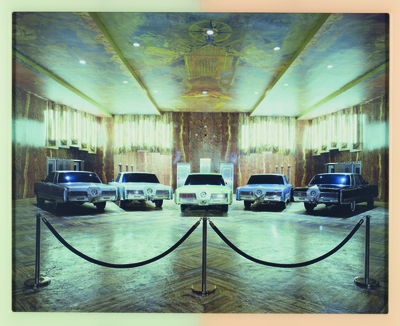LEGACY: PHOTOGRAPHS FROM THE EMILY FISHER LANDAU COLLECTION
Legacy is a focused exhibition winnowed from a much larger collection of promised gifts, by an illustrious donor, to the Whitney Museum of American Art. It is also a telling demonstration of the meaning of “visionary” in the context of collecting contemporary photography. As beautiful as this array is, it is not easy to digest. The pictures can be stubborn and insistent. Almost all of them involve backstories (something, it must be noted, the wonderfully well-informed gallery-sitters brim with eagerness to provide) concerning conceptual underpinnings, referential richness, and procedural intricacies otherwise inaccessible without a little foreknowledge, or time spent researching.
At first glance, what is most impressive about the photographs is their emphatic presence—their “there-ness”—which is sometimes a matter of scale, sometimes of material substance (how they are mounted, physically), and sometimes an issue of spectacular and exquisite optical clarity. Some works are simply beautiful: John Dugdale’s hand-coated cyanotype of a Farmhouse Inverted in Venini Vase Stone Ridge, NY, or Lynn Davis’s extraordinary silver gelatin print of a Greenland iceberg.

Matthew Barney, CREMASTER 3: 1967 Chrysler Imperial, 2002, chromogenic print in self-lubricating plastic frame, 43¼ x 53½ x 11/8″. Whitney Museum of American Art, New York; Promised gift of the Fisher Landau Center for Art P.2010.296a-b, © Matthew Barney. Photo: Tim Nighswander / Imaging4Art.
Other photographers explore presentation in surprisingly sensual ways. Victoria Sambunaris’s incandescent image of a Utah copper mine is mounted on aluminum, its frame the three-dimensional space between it and the wall behind. Matthew Barney’s chromogenic print of the interior of a 1967 Chrysler Imperial showroom is mounted in a “self-lubricating” frame (half pink, half blue) that mimics the translucency of a grapefruit-flavored jelly bean. Richard Artschwager’s Cerise takes a page from sculptor Marisol Escobar, mounting full-scale photographs of a child in a high chair with top, side, and front and back views fixed to the corresponding plane of a huge wood block.
Still others are layered with telling, and autobiographical, mystery. In Robert Mapplethorpe’s Self-Portrait, his face and hand (which grasps a cane carved with a death’s head), equivalent in scale, emerge like spectres against a velvety darkness. Shirin Neshat’s monumental triptych, each image over five feet tall, responds to a book entitled Women without Men. A disembodied woman’s face, eyes closed, stands between images of two standing, bearded men who look out at the viewer. The distance implicit between the genders is as vast as that between the earth and the moon.
